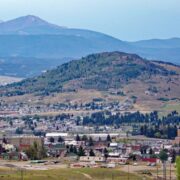
The ancient Romans built incredible constructions using concrete. From a wide system of roads and aqueducts—some of which are in use today—to temples and stadiums, their buildings have stood the test of time. The best example of the use of their incredible building material is the Pantheon, which exemplifies ancient Rome’s brilliance by having the world’s largest unreinforced concrete dome still intact despite being dedicated almost 2000 years ago.
In comparison to modern concrete, historians, archeologists, and engineers have always wondered why Rome’s concrete has lasted so long, especially since today, we can barely keep roads from getting potholes.
News recently broke that researchers may have finally found the answer by isolating “the ingredient that allows Roman concrete to ‘self-heal,’ making it stronger than its modern equivalent. Their ‘back to the future’ findings could help reduce the environmental impact of cement production in today’s society.”
Now, an international team has discovered ancient concrete-manufacturing techniques that incorporated several key ‘self-healing’ properties. For years, researchers believed the key to the ancient concrete’s durability was one ingredient: pozzolanic material, such as volcanic ash from the area of Pozzuoli, on the Bay of Naples.
Previously disregarded as merely evidence of sloppy mixing practices, or poor-quality raw materials, the new study suggests that these tiny lime clasts gave the concrete a previously unrecognized self-healing capability. ‘The idea that the presence of these lime clasts was simply attributed to low quality control always bothered me,’ said MIT professor of civil and environmental engineering Admir Masic. ‘If the Romans put so much effort into making an outstanding construction material, following all of the detailed recipes that had been optimized over the course of many centuries, why would they put so little effort into ensuring the production of a well-mixed final product? There has to be more to this story.’”
Masic and his team have now provided an incredible answer to why Roman concrete looked the way it did.
MIT explains: For many years, researchers have assumed that the key to the ancient concrete’s durability was based on one ingredient: pozzolanic material such as volcanic ash from the area of Pozzuoli, on the Bay of Naples. This specific kind of ash was even shipped all across the vast Roman empire to be used in construction, and was described as a key ingredient for concrete in accounts by architects and historians at the time.
Historically, it had been assumed that when lime was incorporated into Roman concrete, it was first combined with water to form a highly reactive paste-like material, in a process known as slaking. But this process alone could not account for the presence of the lime clasts. Masic wondered: “Was it possible that the Romans might have actually directly used lime in its more reactive form, known as quicklime?”
Studying samples of this ancient concrete, he and his team determined that the white inclusions were, indeed, made out of various forms of calcium carbonate. And spectroscopic examination provided clues that these had been formed at extreme temperatures, as would be expected from the exothermic reaction produced by using quicklime instead of, or in addition to, the slaked lime in the mixture. Hot mixing, the team has now concluded, was actually the key to the super-durable nature.
“The benefits of hot mixing are twofold,” Masic says. “First, when the overall concrete is heated to high temperatures, it allows chemistries that are not possible if you only used slaked lime, producing high-temperature-associated compounds that would not otherwise form. Second, this increased temperature significantly reduces curing and setting times since all the reactions are accelerated, allowing for much faster construction.”
During the hot mixing process, the lime clasts develop a characteristically brittle nanoparticulate architecture, creating an easily fractured and reactive calcium source, which, as the team proposed, could provide a critical self-healing functionality. As soon as tiny cracks start to form within the concrete, they can preferentially travel through the high-surface-area lime clasts. This material can then react with water, creating a calcium-saturated solution, which can recrystallize as calcium carbonate and quickly fill the crack, or react with pozzolanic materials to further strengthen the composite material. These reactions take place spontaneously and therefore automatically heal the cracks before they spread. Previous support for this hypothesis was found through the examination of other Roman concrete samples that exhibited calcite-filled cracks.
Science noted, “When the team created small cracks in the concrete—as would happen as the material aged—and then added water (as would happen with rainwater in the real world), the lime lumps dissolved and recrystallized, effectively filling in the cracks and keeping the concrete strong, the researchers report today in Science Advances. “This has an incredible impact,” Masic says.
Modern concrete typically doesn’t heal cracks larger than 0.2 or 0.3 millimeters across. The team’s Roman-inspired concrete, in contrast, healed cracks up to 0.6 millimeters across.
Masic hopes the work will inspire today’s engineers to improve their own concrete, perhaps with quicklime or a related compound. Indeed, he says, a startup concrete company plans to employ the new discovery. The material wouldn’t just be less expensive than current self-healing concrete, Masic says, it could also help fight climate change: Cement production accounts for 8% of greenhouse gas emissions.”
Who knows, maybe soon we’ll have smoother roads. If we do, it’ll be the ancient Romans who deserve our thanks.
[Read More: Is Alzheimer’s On The Road To Being Cured?]










Apply to our buildings